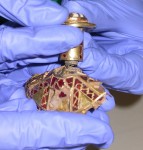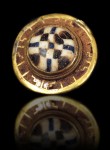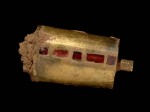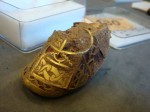 Conservators have discovered that three gold, garnet and enamel pieces from the Staffordshire Hoard which bore no immediately obvious relation to each other fit together to form a beautifully perplexing mystery object.
Conservators have discovered that three gold, garnet and enamel pieces from the Staffordshire Hoard which bore no immediately obvious relation to each other fit together to form a beautifully perplexing mystery object.  The millefiori stud (catalogue number K545), a gold mount with a collar of garnets and a glass enameled checkerboard surface, has a rectangular hole on the under side surrounded by four smaller round holes. A small gold cylinder (K1055) decorated with cloisonné garnets has a rectangular protuberance of silver on one end and four round holes. The cylinder’s tab A fits into the millefiori’s slot B perfectly, and the four holes on both pieces align.
The millefiori stud (catalogue number K545), a gold mount with a collar of garnets and a glass enameled checkerboard surface, has a rectangular hole on the under side surrounded by four smaller round holes. A small gold cylinder (K1055) decorated with cloisonné garnets has a rectangular protuberance of silver on one end and four round holes. The cylinder’s tab A fits into the millefiori’s slot B perfectly, and the four holes on both pieces align.
 On the bottom end, the cylinder has another set of four matching holes with a torn piece of silver plate in the center. That torn plate in turn matches precisely the torn silver in the center of an elaborate gold cloisonné garnet circular object (K130).
On the bottom end, the cylinder has another set of four matching holes with a torn piece of silver plate in the center. That torn plate in turn matches precisely the torn silver in the center of an elaborate gold cloisonné garnet circular object (K130).  The silver plate in the middle was riveted to the gold circle by four rivets, same as the holes on the other two pieces. Those four rivet holes show up on the other side of K130, too, so our mystery object has at least one more part.
The silver plate in the middle was riveted to the gold circle by four rivets, same as the holes on the other two pieces. Those four rivet holes show up on the other side of K130, too, so our mystery object has at least one more part.
(Aesopian interlude: as historian David Starkey noted at the time, this is why it’s so important to keep archaeological discoveries intact in their proper context. If the hoard had been broken up and sold to the highest bidder, those pieces could have been scattered to the four corners of the earth.)
As for what it might have been used for, researchers have proposed several possibilities.
(1) A fitting on a saddle.
(2) The decorative tip to a shield boss, presumably from a very elaborate shield. (In this case the object would have been rivetted to the top / front of a standard iron shield boss. A warrior held his shield by grasping a handgrip that ran across a circular hole cut in the centre of the shield. The domed boss covered the hole while leaving space for the warrior’s hand inside.)
(3) A decorative top to a stopper that fitted into a drinking horn. (Here the object would have been rivetted to a wooden stopper that fitted inside the mouth of the horn.)
(4) A decorative terminal to a parchment roll. (I think the suggestion is that there would be one at each end of the roll, fixed to whatever the roll was attached to.)
(5) A lid to something. But what? (Again this probably requires the object being rivetted to something like a wooden stopper.)
You can see how the first two pieces — the millefiori stud and the cylinder — came together thanks to perspicacious curator Deborah Magnoler in the following video from this summer. The gentleman with her is Dr. David Symons, curator of the Birmingham Museums and Art Gallery, the museum that shares ownership of the hoard with The Potteries Museum & Art Gallery in Stoke-On-Trent.
[youtube=http://www.youtube.com/watch?v=Mh_tNPXYPBE&w=430]
Finally, and I’m really surprised at how little this has been advertised, some of the Staffordshire Hoard is coming to America! One hundred of the most important pieces, including gold and garnet sword pommels, the folded gold cross and the strip of gold with the Latin Biblical inscription, will be on display at the National Geographic Museum in Washington, D.C., starting next Saturday, October 29! The exhibit runs until March 4, 2012 so you have five months to claw your way there before all the pretty shiny heads back home.
Interesting! Agree very much with David Starkey, the perfect example to prove he’s right!
Can they find the fourth artifact and assemble the superweapon before Cobra does? :ohnoes:
amazing :yes: